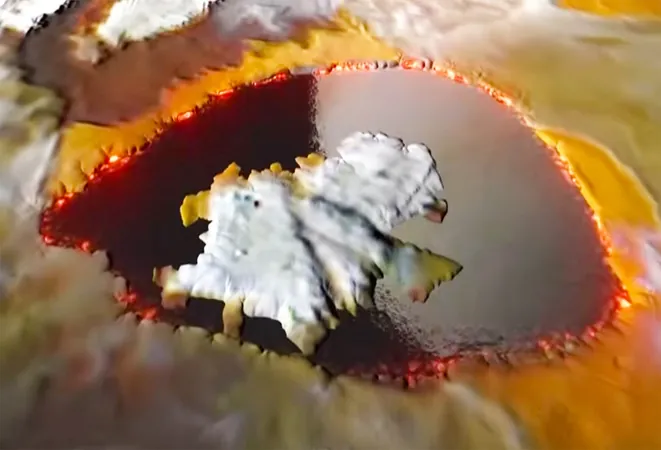
NASA Unveils Stunning 'Glass-Smooth Lake of Cooling Lava' on Jupiter's Volcanically Active Moon Io
2025-04-05
Author: Daniel
Jupiter's moon Io continues to astound scientists with its intense volcanic activity and extraordinary landscapes. Known for being the most geologically active body in the solar system, Io features a mesmerizing scene of glowing lava lakes and spectacular eruptions that propel sulfur and magma to great heights.
The moon’s extreme environment, marked by a thin atmosphere and relentless radiation, serves as a unique laboratory for understanding the complex processes that shape not just Io, but also the entire Jovian system. Recent insights from NASA's Juno mission — which has been observing Jupiter and its moons since its launch in 2011 — shed new light on the moon's dynamic geology.
In an impressive feat, Juno recently completed close flybys of Io, coming within approximately 930 miles of its surface. Scott Bolton, the mission's principal investigator from the Southwest Research Institute, remarked on the incredible findings from these encounters, which captured Io's northern regions in unprecedented detail.
Unveiling the Volcanic Majesty of Io
Io's volcanism is unparalleled, driven by the immense gravitational pull from Jupiter, coupled with the gravitational influences of its neighboring moons. This interplay creates significant internal heating that fuels eruptions capable of launching volcanic material hundreds of miles from their origin. The results? A vivid palette of yellows, reds, and whites on the surface, stemming from sulfur and various volcanic flows.
Notably, Juno's instruments captured a striking lake of cooling lava known as Loki Patera, measuring around 200 kilometers (127 miles) in length. The data revealed that parts of this lava lake are remarkably smooth, with surface characteristics akin to glass. This "glass-smooth" appearance is reminiscent of obsidian, formed from rapidly cooled volcanic lava on Earth.
Researchers also utilized Juno's Microwave Radiometer (MWR) to analyze temperature variations across Io, discovering that the cooler regions tend to be situated at the poles, indicating the concentrated volcanism elsewhere on the moon. This insight provides a deeper understanding of the heat dynamics at play beneath Io's constantly shifting surface.
Juno's Mission: Unlocking the Mysteries of Jupiter and Its Moons
As Juno continues its mission, it is also collecting vital data on Jupiter itself, including an examination of the giant planet's water content. Understanding the distribution of elements like oxygen and hydrogen in Jupiter’s atmosphere is crucial for piecing together the solar system's formation history. Initial findings have shown that regions near Jupiter’s equator have a water abundance approximately three to four times greater than expected, suggesting the Galileo probe may have inadvertently sampled an atypically dry area during its own mission in 1995.
The data gathered by the Juno mission not only enhances our knowledge of Io's surface and internal processes but also holds the potential to reshape our understanding of Jupiter’s core and how it formed.
What Lies Ahead?
The Juno mission's extended journey will continue to provide more insights into both Jupiter and its moons. Future flybys promise to reveal additional secrets of Io’s volcanic activity and possibly its water content, all contributing to our understanding of this fascinating celestial neighbor.
With its breathtakingly violent beauty and unique geological features, Io proves to be more than just a moon; it is a vital piece of the puzzle in the ongoing exploration of our solar system. Stay tuned as Juno uncovers more of the astonishing mysteries of this fiery world!




 Brasil (PT)
Brasil (PT)
 Canada (EN)
Canada (EN)
 Chile (ES)
Chile (ES)
 Česko (CS)
Česko (CS)
 대한민국 (KO)
대한민국 (KO)
 España (ES)
España (ES)
 France (FR)
France (FR)
 Hong Kong (EN)
Hong Kong (EN)
 Italia (IT)
Italia (IT)
 日本 (JA)
日本 (JA)
 Magyarország (HU)
Magyarország (HU)
 Norge (NO)
Norge (NO)
 Polska (PL)
Polska (PL)
 Schweiz (DE)
Schweiz (DE)
 Singapore (EN)
Singapore (EN)
 Sverige (SV)
Sverige (SV)
 Suomi (FI)
Suomi (FI)
 Türkiye (TR)
Türkiye (TR)
 الإمارات العربية المتحدة (AR)
الإمارات العربية المتحدة (AR)